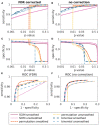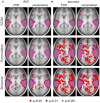Searchlight Classification Informative Region Mixture Model (SCIM): Identification of Cortical Regions Showing Discriminable BOLD Patterns in Event-Related Auditory fMRI Data
- PMID: 33597841
- PMCID: PMC7882477
- DOI: 10.3389/fnins.2020.616906
Searchlight Classification Informative Region Mixture Model (SCIM): Identification of Cortical Regions Showing Discriminable BOLD Patterns in Event-Related Auditory fMRI Data
Abstract
The investigation of abstract cognitive tasks, e.g., semantic processing of speech, requires the simultaneous use of a carefully selected stimulus design and sensitive tools for the analysis of corresponding neural activity that are comparable across different studies investigating similar research questions. Multi-voxel pattern analysis (MVPA) methods are commonly used in neuroimaging to investigate BOLD responses corresponding to neural activation associated with specific cognitive tasks. Regions of significant activation are identified by a thresholding operation during multivariate pattern analysis, the results of which are susceptible to the applied threshold value. Investigation of analysis approaches that are robust to a large extent with respect to thresholding, is thus an important goal pursued here. The present paper contributes a novel statistical analysis method for fMRI experiments, searchlight classification informative region mixture model (SCIM), that is based on the assumption that the whole brain volume can be subdivided into two groups of voxels: spatial voxel positions around which recorded BOLD activity does convey information about the present stimulus condition and those that do not. A generative statistical model is proposed that assigns a probability of being informative to each position in the brain, based on a combination of a support vector machine searchlight analysis and Gaussian mixture models. Results from an auditory fMRI study investigating cortical regions that are engaged in the semantic processing of speech indicate that the SCIM method identifies physiologically plausible brain regions as informative, similar to those from two standard methods as reference that we compare to, with two important differences. SCIM-identified regions are very robust to the choice of the threshold for significance, i.e., less "noisy," in contrast to, e.g., the binomial test whose results in the present experiment are highly dependent on the chosen significance threshold or random permutation tests that are additionally bound to very high computational costs. In group analyses, the SCIM method identifies a physiologically plausible pre-frontal region, anterior cingulate sulcus, to be involved in semantic processing that other methods succeed to identify only in single subject analyses.
Keywords: GMM; MVPA; SVM; fMRI; p-values; searchlight classification.
Copyright © 2021 Urbschat, Uppenkamp and Anemüller.
Conflict of interest statement
The authors declare that the research was conducted in the absence of any commercial or financial relationships that could be construed as a potential conflict of interest.
Figures













Similar articles
-
Atlas-Based Classification Algorithms for Identification of Informative Brain Regions in fMRI Data.Neuroinformatics. 2020 Apr;18(2):219-236. doi: 10.1007/s12021-019-09435-w. Neuroinformatics. 2020. PMID: 31402435
-
Prioritizing spatial accuracy in high-resolution fMRI data using multivariate feature weight mapping.Front Neurosci. 2014 Apr 16;8:66. doi: 10.3389/fnins.2014.00066. eCollection 2014. Front Neurosci. 2014. PMID: 24795548 Free PMC article.
-
Fast Gaussian Naïve Bayes for searchlight classification analysis.Neuroimage. 2017 Dec;163:471-479. doi: 10.1016/j.neuroimage.2017.09.001. Epub 2017 Sep 4. Neuroimage. 2017. PMID: 28877514
-
Predicting brain states associated with object categories from fMRI data.J Integr Neurosci. 2014 Dec;13(4):645-67. doi: 10.1142/S0219635214500241. J Integr Neurosci. 2014. PMID: 25352153
-
Linear Discriminant Analysis Achieves High Classification Accuracy for the BOLD fMRI Response to Naturalistic Movie Stimuli.Front Hum Neurosci. 2016 Mar 31;10:128. doi: 10.3389/fnhum.2016.00128. eCollection 2016. Front Hum Neurosci. 2016. PMID: 27065832 Free PMC article.
Cited by
-
Exploring the Embodied Mind: Functional Connectome Fingerprinting of Meditation Expertise.Biol Psychiatry Glob Open Sci. 2024 Aug 9;4(6):100372. doi: 10.1016/j.bpsgos.2024.100372. eCollection 2024 Nov. Biol Psychiatry Glob Open Sci. 2024. PMID: 39309211 Free PMC article.
References
-
- Akama H., Murphy B., Lei M. M., Poesio M. (2014). Cross-participant modelling based on joint or disjoint feature selection: an fMRI conceptual decoding study. Appl. Inform. 1, 1–21. 10.1186/2196-0089-1-1 - DOI
LinkOut - more resources
Full Text Sources
Other Literature Sources

